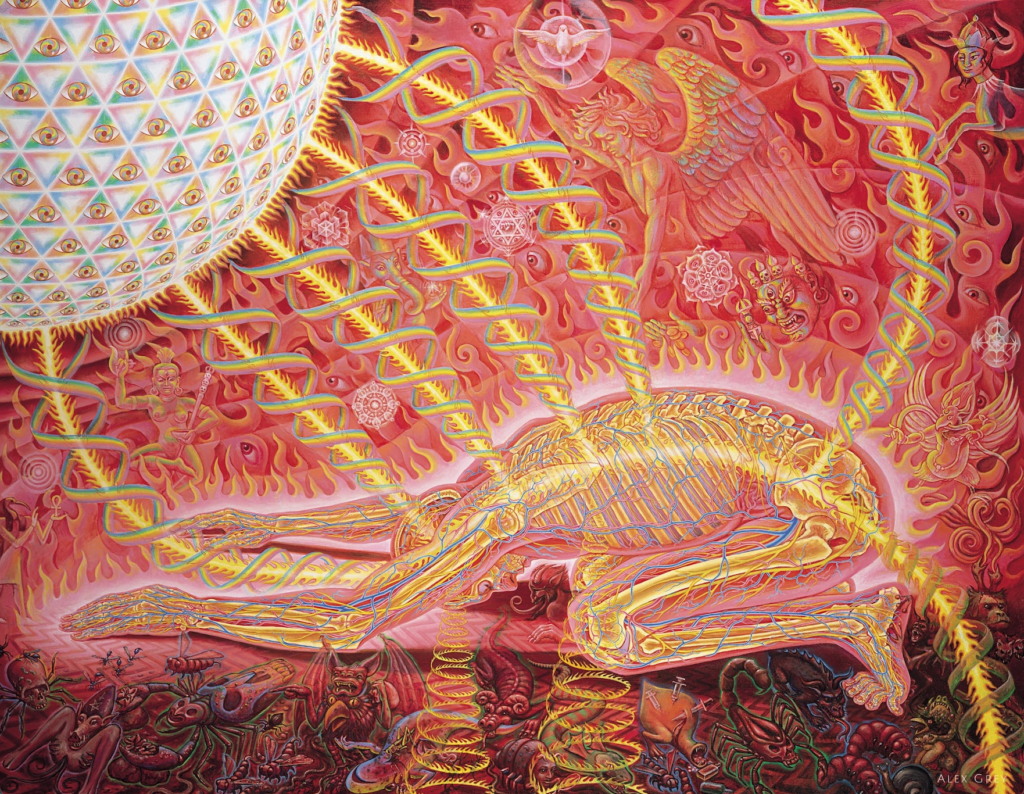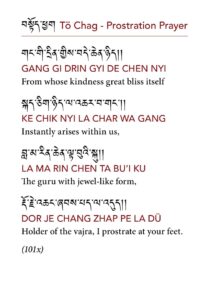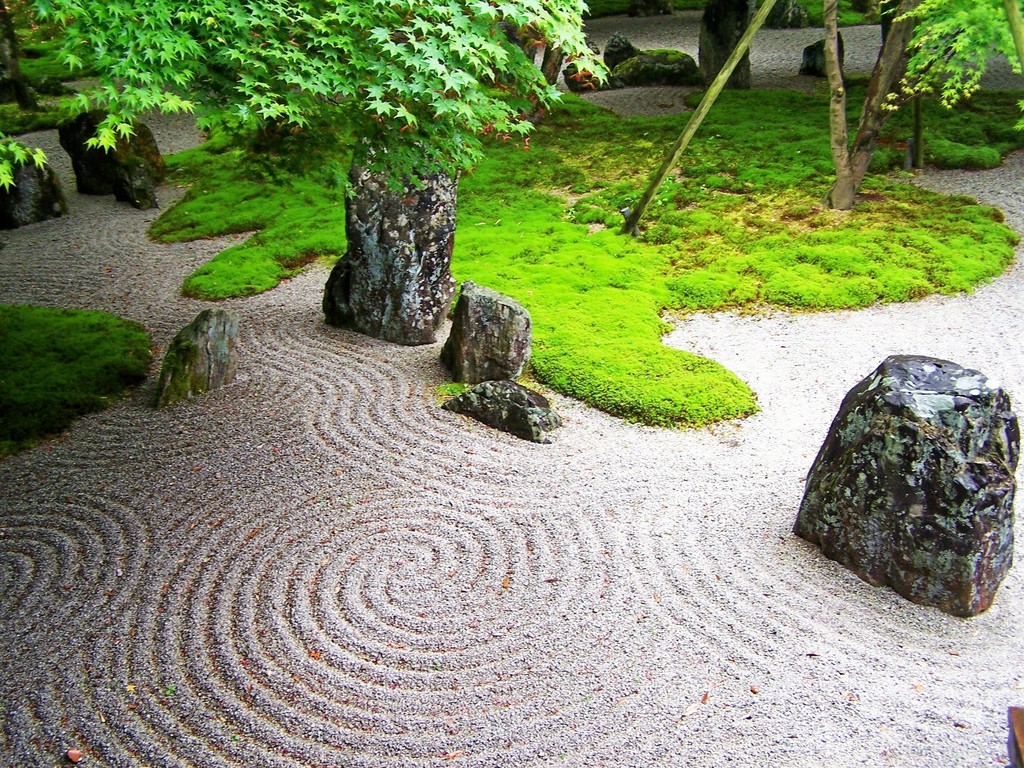The Foundation Practice of Prostrations

Making appearances are such beings as Ganesha, the elephant headed tantric deity of India, a Tibetan Buddhist vajra dakini, Thoth, the symbol of occult magician Hermes Trismegistus, Garuda, transcendental bird of the yogis, the Barak, a feminine headed mule which took Mohammed on his fateful ride to heaven on the night he had his vision which led to writing the Koran, a Christian angel and dove of the holy spirit, etc.
The obstacles are themselves portrayed as specific demons, such as mockery, greed, jealousy, anger, sloth, blasphemy and lust which scitterscatter through the shadow of the prostrate figure. Alex Grey 1993-1995
Purification of Body, Speech and Mind
In Tibetan, the word prostration is translated as chak tsal. Chak means to “sweep away” harmful actions and obscurations. Tsal means we receive the blessings of an enlightened body, speech and mind.
“When we do prostrations we act on the level of body, speech, and mind,” wrote Lama Gendyn Rinpoche. “The result of doing them is a very powerful and thorough purification. This practice dissolves all impurities, regardless of their kind, because they were all accumulated through our body, speech, and mind. Prostrations purify on all three levels.”
A Tantric Goal: Working our “Energy Wind Body”
To advanced tantric practitioners, prostrations help us work our subtle bodies—”energy-wind body” as it’s sometimes translated. The energy of the subtle body—known variously as Chi, Prana, Winds—is visualized in this practice.
Author and teacher Rob Preece described his own early work with prostrations: “When I was doing these prostrations in Bodhgaya, there were a number of other Westerners going through the same process nearby, and I could see this emotional upheaval happening in them as well. Some days I was in excruciating pain, while the person next to me was ecstatic, and the next day she was in a flood of tears, and it was my turn to feel ecstatic.” What he was describing was the process of the energy-wind body releasing blocked “toxic energy that had been held so long.” He added, “I could really feel purification was taking place.”
Energy Wind Body, or subtle body, is well accepted in most Eastern traditions, and to some extent by science in the west, via the success of Acupuncture in controlling pain. Rob Preece, who is a working psychologist, also describes Energy Wind Bodies as analogous to emotions, with wind connoting emotion. In my very basic layman’s understanding, for example, guilt or repressed emotional memories might be imprinted on our psyche, sometimes without our explicit knowledge. The famous psychologist, Carl Jung, described this bundle of repressed, unpleasant memories and guilt trips as the “Shadow.” Just like karma seeds in Buddhism, the shadow can ripen and affect us tangibly in our lives, often with tragic consequences. Working with prostrations releases the trapped “winds” or emotions, the collected guilt, thus purifying our karma.
Another way of understanding winds or chi is as subtle energies in the body. Acupuncture, Tai Chi—and prostrations—can work to manipulate or enhance these energies.
Proper Motivation
When we set the motivation, it becomes a Mahayana Buddhist practice, focused on Bodhichitta—on kindness and regard for all sentient beings. The benefits then become as wide and expansive as the collective of sentient beings.
How to Prostrate
The body aspect of the practice is purely physical, involving the whole body, and pressing the entire body flat to the ground at the lowest point, in full contact with the earth. The speech aspect is normally the mantra or praise we chant as we prostrate (mentally, or aloud).
Visualization: Even if we are bowing to a physical altar, some level of visualization is practiced to fully involve our minds in the practice. In formal prostrations, you might also visualize the entire “merit tree” or “field of merit”—all of the enlightened beings gathered in front of you, surrounding your main practice deity, Buddha or guru.
Involve All Sentient Beings: One valuable technique for developing Bodhichitta is to visualize all sentient beings around you (in front, beside and behind you), also prostrating. Most people can’t manage a detailed visualization of so many, but the key is to just understand that you are bowing on behalf of ALL sentient beings.
Clasp the hands together above the head. As we draw the hands down to touch our head we visualize light purifying our bodies of all its obscurations and negativities. (If you can’t visualize, simply understand that your body is symbolically purified by the action.)
As we draw down our clasped hands to our throat level, we visualize light purifying our speech.
As we draw down our clasped hands to our heart level, where traditionally our mind resides, we visualize or understand that our mind is purified.
Five-Point-Prostration: We quickly kneel, and our head touches the floor, so that now our knees, hands and head are touching the earth in five places. We visualize or understand that our five negative or disturbing emotions—anger, attachment, ignorance, jealousy, and ignorance—are leaving our body and flowing into the earth. This final act symbolically completely purifies us.
Without hesitation we rise up and begin the next prostration.

Excerpts from Buddha Weekly
For online prostration schedule: https://www.sacredpathmedicine.com/calendar/





